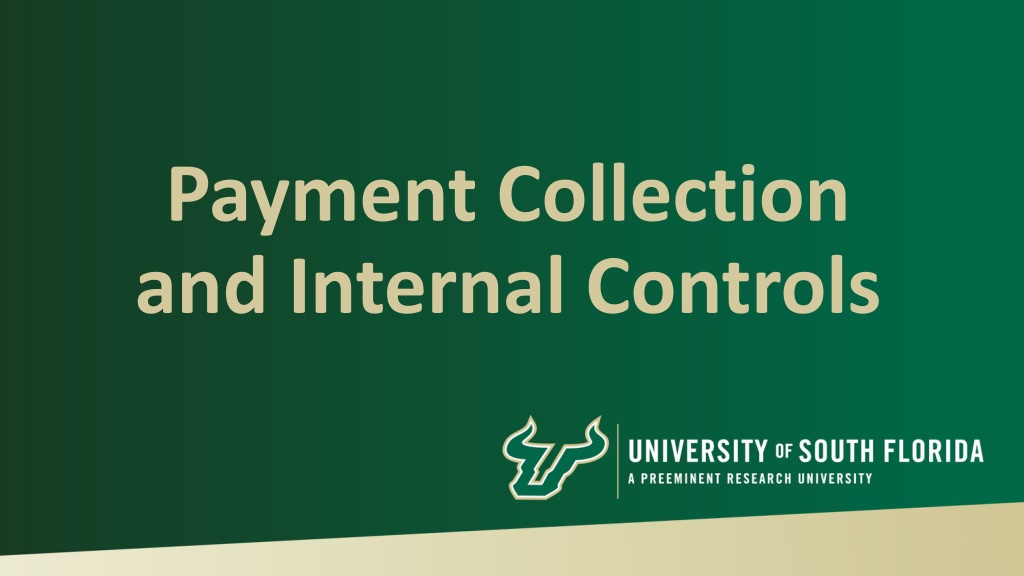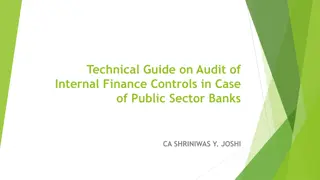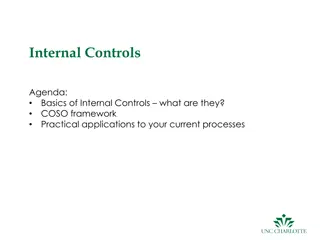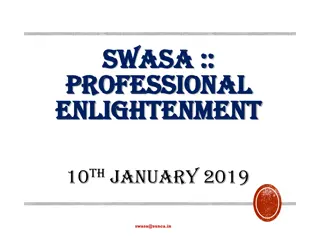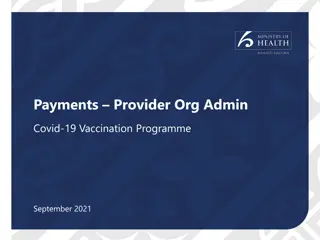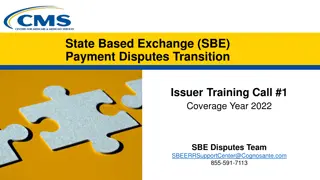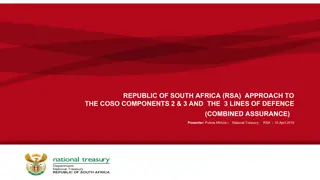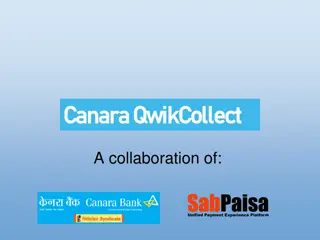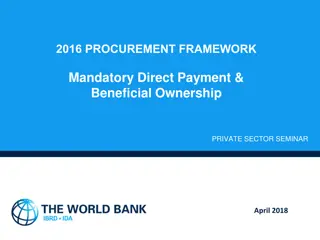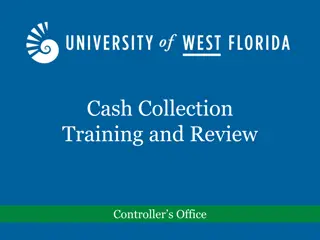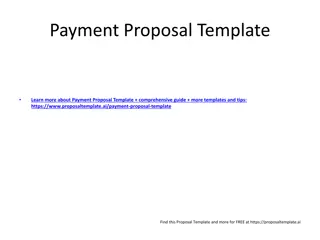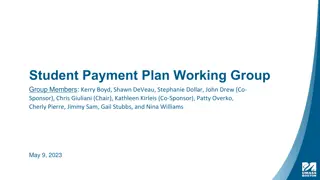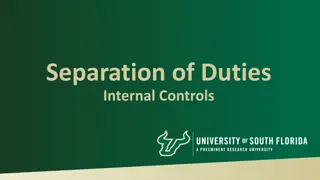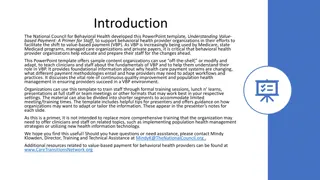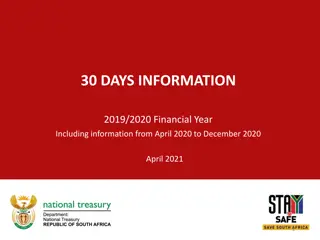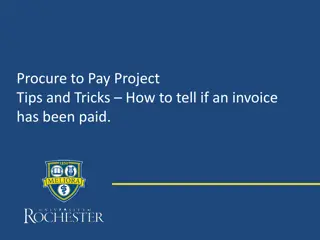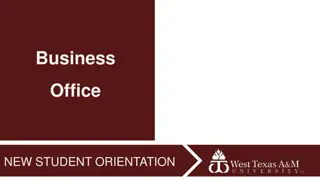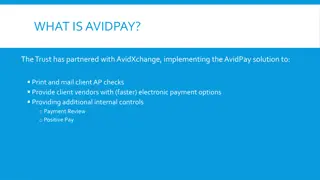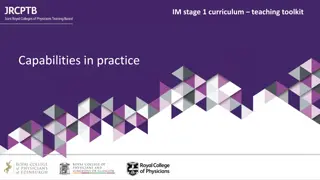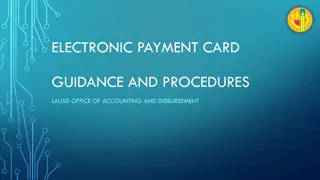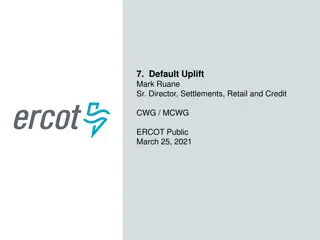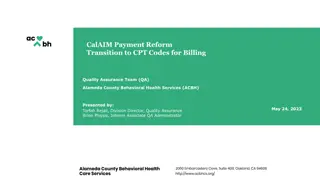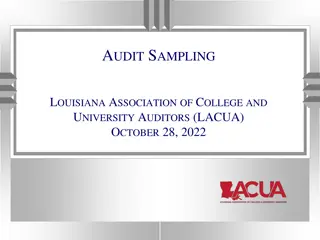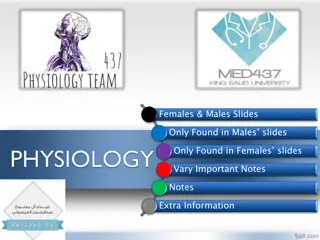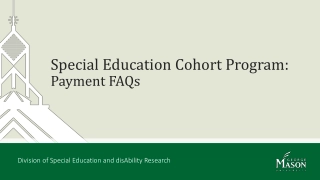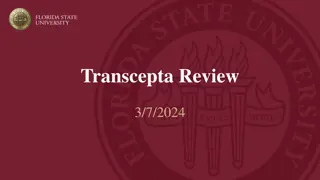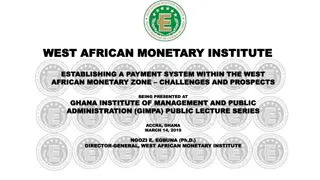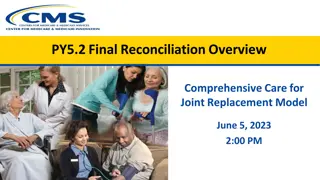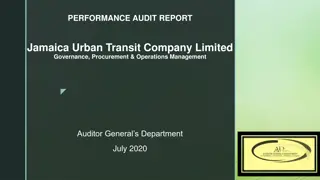Ensuring Effective Internal Controls for Payment Collection
Enhance USF business practices by establishing strong internal controls for accepting payments. Learn about segregation of duties, defining accountability, and the role of internal controls in protecting funds and ensuring compliance with regulations and laws.
Download Presentation

Please find below an Image/Link to download the presentation.
The content on the website is provided AS IS for your information and personal use only. It may not be sold, licensed, or shared on other websites without obtaining consent from the author. Download presentation by click this link. If you encounter any issues during the download, it is possible that the publisher has removed the file from their server.
E N D
Presentation Transcript
Payment Collection and Internal Controls
Agenda Enhance USF Business Practices Establish Internal Controls related to accepting payments at the University How to apply appropriate segregation of duties The roles, responsibilities, procedures and constraints associated with each step Four Functions of Segregation of Duties Record Keeping Authorization Custody Reconciliation 2
Accountability & Internal Controls Defining Accountability Internal Controls Examples
Defining Accountability Delegation of authority to qualified persons to: Initiate, approve, process and review business transactions Holding these persons responsible for: The validity, correctness and appropriateness of their actions 4
Accountability Everyone is accountable for their actions Of all the individuals involved in the receipt, recording and balancing of funds, the person of ultimate responsibility is the custodian Payment processors are accountable for Recording payments accurately Observing all of the USF internal controls Protecting the cardholders information Supervisors are accountable for Proper allocations of payments Assignment of duties that comply with separation of duties guidelines Others are accountable for Proper transfer of custody of payments Accountable officers are ultimately responsible for payment transactions. 5
Internal Controls Protect USF USF staff Are designed to provide reasonable assurance regarding: Effectiveness and efficiency of operations Reliability of reporting Compliance with applicable rules, laws, and regulations 6
Internal Controls as They Relate To Cash Management Internal controls specifically ensure: The safety of all funds The timeliness of recording the receipt of all funds That assignment of duties complies with separation of duties guidelines That reconciliations are completed and reviewed on a monthly schedule A sound audit trail and adequate documentation are created Find specifics on internal controls on: www.usf.edu/businessprocesses 7
Internal Controls - Examples Generally, access to credit card terminals and POS systems must be limited to a primary and a secondary custodian Physical safety of the information and equipment must be ensured at point of collection and then stored overnight All adjustments must be documented and approved by a supervisor (authorizer) The payments must balance to the system where the payments were recorded Deposits must be reconciled to the general ledger 8
Segregation of Duties Defining Segregation of Duties The Four Functions of Segregation of Duties Record Keeping Authorization Custody Reconciliation When Segregation is not possible Examples
Separation of Duties Separation of duties protects USF and the individual by ensuring that no one person has the ability to control all of the steps involved in handling and accounting for money received by USF. Custody Record Keeping The ideal is that any one person performs only one function; four people are needed for the four functions Authorization Reconciliation 10
Four Functions of Segregation of Duties The four functions are Record Keeping, Authorization, Custody and Reconciliation The ideal is that any one person performs only one function; four people are needed for the four functions If one person performs two functions Risk exists that presents the opportunity for something to go wrong A compensating control is needed to reduce the risk The compensating control might be an extra layer of review 11
When Segregation Is Not Possible If one person performs two or more of the functions: Risk exists that presents the opportunity for something to go wrong A compensating control is needed to reduce the risk The compensating control might be an extra layer of review 13
Examples of Compensating Controls A manager may perform a high level of review of detailed transaction reports A manager may periodically sample transactions and request supporting documentation to ensure the transactions are complete, appropriate, and accurate. Someone from an another area may perform an external review of a reconciliation. For instance two departments within a college may share responsibility to review each others reconciliations. Some colleges and units have a centralized business services department 14
Record Keeping Defining Record Keeping Retention Examples
Record Keeping Record keeping is the process of creating and maintaining official records Record keeping may occur manually or through an automated data system Record Keeping Examples: o Mail log paper or electronic o Customer receipts o Official USF pre-numbered cash receipts o System generated cash receipts o Deposit slips o Credit card receipts o Cash register reports o EFT (electronic funds) payment documents o Balancing and reconciliation reports 16
Record Keeping - Retention Observe record retention requirements o Find information on Online Business Processes o Also find information on the Purchasing web site Records serve multiple needs o Compliance with best business practices o Helpful in researching a question 17
Authorization Defining Authorization Best Practices
Authorization Authorization is the process of granting formal approval to perform a specific function For example, someone must be authorized in order to perform one of the following functions: Verify cash collections Review daily balancing reports Approve discounts, voids, or refunds 19
Authorization The person who originally created a transaction should not be: The one who makes a correction The one who creates a void The one who creates/approves a refund The best practice is to have a supervisor take these actions 20
Custody Defining Custody System Passwords Register Keys Storage of Funds
Custody Having access to or control over any physical asset Custodians: Collect and handle payments Prepare deposits Have access to safes, lock boxes, & file cabinets where funds are kept Custodians of petty cash funds or change funds 22
Custody System Passwords All cash registers or Point of Sale (POS) systems should be password protected to assign accountability and fix responsibility Every person must have their own password Passwords must never be shared Don t write your passwords down If you need to leave the work area, sign off your password; log back on when you return Passwords should be changed periodically Passwords should be inactivated whenever a custodian vacates the position 23
Custody Register Keys If your cash register or point-of-sale system uses key access: Only essential staff should possess the keys An inventory of the keys should be kept Keys should never be shared Keys must be collected whenever a custodian vacates the position Custody Storage of Funds The safe or lock box combination should be changed: Any time an employee with knowledge of the combination or access to the key terminates or is reassigned Periodically Funds should never be stored in a desk, even if it is locked 24
Reconciliation Defining Reconciliation Why Reconcile? Transaction Reconciliation Non-Inventory Reconciliation Credit Card Reconciliation Reconciliation Guidelines
Reconciliation & Balancing Cashier Balancing Check Log Balance 26
Defining Reconciliation A reconciliation is simply a comparison of two sets of information as of the same point in time Identify the differences between what actually did post in Finance Mart vs. what you expected to post in Finance Mart Why Reconcile? Good internal controls and sound business practices necessitate the reconciliation of funds by business staff USF needs assurance that all assets are safeguarded and used to the best benefit of the university 27
What Do We Reconcile? Point of sale transactions ( POS ) Check logs Bank card payments E check payments Transaction posting in FAST and FM Credit Cards Inventory 28
Point of Sale Transactions ( POS ) The POS system should Record sales and cash collections Produce a daily detailed sales report Produce a pre-numbered customer receipt Reconciliations to perform Balance the cash drawer Balance the day s sales to actual collections Reconcile daily balancing sheet to deposit 29
Transaction Reconciliation Reconcile Deposits to accounts receivable postings Deposits to general ledger postings Inventory to sales Finance Mart is the official reporting system Confirm that correct chart fields were used Submit corrections immediately Confirm that corrections posted correctly Find detail in FAST or OASIS 30
Non-Inventory Reconciliation Some sales may not involve tangible inventory To ensure that all billings have been completed, review Room usage logs Equipment or lab usage logs Participant lists or class rolls Order forms or contracts for services 31
Credit Card Reconciliation When credit cards are used with a POS POS system should produce a report of credit card transactions Compare the POS report to the daily settlement report Supervisor reviews this 32
Reconciliation - Guidelines Reconciliation must be performed by a person with no cash handling responsibilities The reconciliation must be dated and signed or initialed The reconciliation should be reviewed by an independent party The prescribed procedure should be followed; find reconciliation resources on the UCO web site 33
Good Business Practices Oversight and Monitoring of Accounts Receivable (AR)
Oversight & Monitoring of Accounts Receivable Outstanding AR is reviewed at least monthly Someone other than the person who maintains AR conducts the review 35
Are you ready for the Quiz? Let s review some important information
Review for the Quiz Accountability Payment processors are accountable for Recording payments correctly Observing USF internal controls Internal controls exist To protect the staff To protect the cash Custody Having access to or control over any physical asset 37
Review for the Quiz Record Keeping The process of creating and maintaining departmental documents A supervisor should always review your balancing report; then initial and date the form Authorization The person who receives a payment should never make a correction, issue a refund, or void a transaction The authorizer performs these actions Balancing Your department should have a standard balancing report 38
Resources Office of University Audit & Compliance Generalcounsel.usf.edu Online Business Processes http://www.usf.edu/businessprocesses Additional training resources are available on the University Controllers Office website UCO Website > About UCO > Training > Banking and Cash Management Credit Card Reconciliation Process Lock Boxes and ACH s Internal Controls Separation of Duties 39
